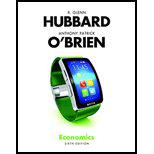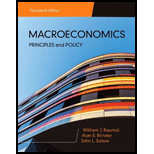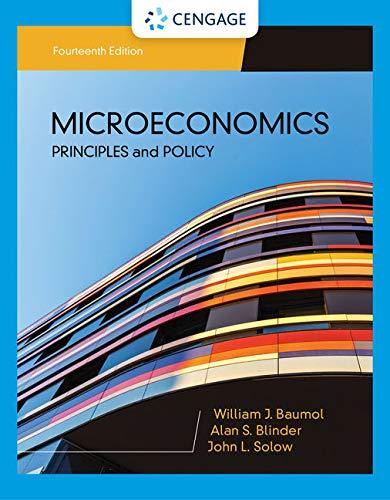
Economics Plus MyLab Economics with Pearson eText (2-semester Access) -- Access Card Package (6th Edition) (The Pearson Series in Economics)
6th Edition
ISBN: 9780134417295
Author: R. Glenn Hubbard, Anthony Patrick O'Brien
Publisher: PEARSON
expand_more
expand_more
format_list_bulleted
Textbook Question
Chapter 6, Problem 6.2.7PA
The entrance fee into Yellowstone National Park in northwestern Wyoming is “$50 for a private, noncommercial vehicle; $40 for a motorcycle; or $20 for each visitor 16 and older entering by foot, bike, ski, etc.” The fee provides the visitor with a seven day entrance permit into Yellowstone and nearby Grand Teton National Park.
- a. Would you expect the demand for entry into Yellowstone National Park for visitors in private, noncommercial vehicles to be elastic or inelastic? Briefly explain.
- b. There are three general ways to enter the park: in a private, noncommercial vehicle; on a motorcycle; and by foot, bike, or ski. Which way would you expect to have the largest
price elasticity of demand , and which would you expect to have the smallest price elasticity of demand? Briefly explain.
Source: National Park Service, Yellowstone National Park. “Fees, Reservations, and Permits.” http://www.nps.gov/yell/planyourvisit/feesandreservations.htm, 2015.
Expert Solution & Answer
Trending nowThis is a popular solution!

Students have asked these similar questions
Suppose Person A is looking for a health insurance plan on Oregon's health insurance marketplace and they find one with the following details:
Monthly Premium: $331
Deductible: $5,000
Primary care visit to treat injury or illness: $35 copay
Imaging (CT/PET Scans MRIs): 40% coinsurance after deductible
Ambulance: 40% coinsurance after deductible
Inpatient hospital stay: 40% coinsurance after deductible
Suppose further that Person A purchases this plan and it takes effect in January 2022.
The cost Person A pays per month for this health insurance is equal to _. Person A must pay. before coinsurance kicks in.
0000
$35; $5,000
$35; $331
$331; $5,000
$331; $35
Multiple Choice 1 point
Suppose Person A is looking for a health insurance plan on Oregon's health insurance marketplace and you find one with the following details:
Monthly Premium: $331
Deductible: $5,000
Primary care visit to treat injury or illness: $35 copay
Imaging (CT/PET Scans MRIs): 40% coinsurance after deductible
Ambulance:…
Use the figure below to answer the following question. Point X and Y represent two non-ideal contracts that the individual is faced with buying. From this information, you can
conclude that if given the option between points B and Y the individual would prefer:
Utility
A
у в
0000
UKI)
E[Bp IH
point B- the actuarially fair and full contract
point Y-the actuarially unfair but full contract
point Y- the actuarially fair, but partial contract
point B- the actuarially fair, but partial contract
income
2. Another issue facing millennials is the growing income and wealth inequality. We will use
our model to understand the implications of this issue.
A. Begin from the baseline preferences and endowments.
Assume Xavier is wealthier than Yuri.
Xavier has an endowment of 1100 pounds for each period (E1=E2=1100).
Yuri has an endowment of only 900 pounds in each period (E1=E2=900).
Note that each period's market supply is unchanged (1100 + 900 = 1000 + 1000 = = 2000).
Determine the equilibrium interest rate.
r =
%
B. Begin from the baseline preferences and endowments.
Assume Yuri is wealthier than Xavier.
Xavier has an endowment of only 900 pounds in each period (E1=E2=900).
Yuri has an endowment of 1100 pounds for each period (E1=E2=1100).
Note that each period's market supply is unchanged (1100 + 900 = 1000 + 1000 = 2000).
Determine the equilibrium interest rate.
r =
%
C. Begin from the baseline preferences and endowments.
A third person named Zena joins our economy. Zena is very…
Chapter 6 Solutions
Economics Plus MyLab Economics with Pearson eText (2-semester Access) -- Access Card Package (6th Edition) (The Pearson Series in Economics)
Ch. 6 - Write the formula for the price elasticity of...Ch. 6 - If a 10 percent increase in the price of Cheerios...Ch. 6 - Prob. 6.1.3RQCh. 6 - Prob. 6.1.4RQCh. 6 - Prob. 6.1.5PACh. 6 - Prob. 6.1.6PACh. 6 - Prob. 6.1.7PACh. 6 - Prob. 6.1.8PACh. 6 - Prob. 6.1.9PACh. 6 - Prob. 6.1.10PA
Ch. 6 - What are the key determinants of the price...Ch. 6 - Prob. 6.2.2RQCh. 6 - Prob. 6.2.3PACh. 6 - According to a news story about the bus system in...Ch. 6 - Prob. 6.2.5PACh. 6 - Prob. 6.2.6PACh. 6 - The entrance fee into Yellowstone National Park in...Ch. 6 - Prob. 6.3.1RQCh. 6 - Prob. 6.3.2RQCh. 6 - Prob. 6.3.3PACh. 6 - Prob. 6.3.4PACh. 6 - Prob. 6.3.5PACh. 6 - Prob. 6.3.6PACh. 6 - Prob. 6.3.7PACh. 6 - Prob. 6.3.8PACh. 6 - Prob. 6.3.9PACh. 6 - Prob. 6.3.10PACh. 6 - Prob. 6.3.11PACh. 6 - Prob. 6.3.12PACh. 6 - Define the cross-price elasticity of demand. What...Ch. 6 - Prob. 6.4.2RQCh. 6 - Prob. 6.4.3PACh. 6 - Prob. 6.4.4PACh. 6 - Prob. 6.4.5PACh. 6 - Prob. 6.4.6PACh. 6 - Prob. 6.4.7PACh. 6 - Prob. 6.4.8PACh. 6 - Prob. 6.4.9PACh. 6 - Prob. 6.5.1RQCh. 6 - Prob. 6.5.2PACh. 6 - Prob. 6.5.3PACh. 6 - Prob. 6.5.4PACh. 6 - Prob. 6.5.5PACh. 6 - Prob. 6.5.6PACh. 6 - Write the formula for the price elasticity of...Ch. 6 - Prob. 6.6.2RQCh. 6 - Prob. 6.6.3PACh. 6 - Prob. 6.6.4PACh. 6 - Prob. 6.6.5PACh. 6 - Prob. 6.6.6PACh. 6 - Prob. 6.6.7PACh. 6 - Prob. 6.6.8PACh. 6 - Prob. 6.6.9PACh. 6 - Prob. 6.6.10PA
Knowledge Booster
Learn more about
Need a deep-dive on the concept behind this application? Look no further. Learn more about this topic, economics and related others by exploring similar questions and additional content below.Similar questions
- Use the figure below to answer the following question. Let I represent Income when health, let Is represent income when ill. Let E[I] represent expected income. Point D represents Utility 100000 B у いいつ income есва Ін Is the expected utility from income with no insurance an actuarially fair and partial contract an actuarially fair and full contract an actuarially unfair and full contract an actuarially unfair and partial contractarrow_forwardOutline the principles of opportunity cost and comparative advantage. Describe how these principles can be applied to address the scarcity of resources in a real-world scenario involving a company or industry.arrow_forwardNot use ai pleasearrow_forward
- 3. Consider the case of everyone being wealthier in the future, such as from a positive productivity shock (computers, internet, robotics, AI). A. Begin from the baseline preferences and endowments. Give both people an endowment of 1000 pounds for the first period and 1100 pounds for the second. AI increases the supply of second period goods by 10%. Note that there is now a total of 2000 pounds in the first period and 2200 pounds in the second. Determine the equilibrium interest rate. r = % B. Begin from the baseline preferences and endowments. Give both people an endowment of 1100 pounds for the first and 1100 pounds for the second periods. AI increases the supply in all periods by 10%. Note that there are now 2200 pounds in the first period and 2200 pounds in the second. Determine the equilibrium interest rate. r = % C. Explain how productivity and the real rate are connected. Write at least five sentences.arrow_forwardNot use ai pleasearrow_forwardNot use ai pleasearrow_forward
- Not use ai pleasearrow_forwardJim's Bank Account for the Year to 30 April 2008: We will start by calculating the balance of the business bank account, using the transactions provided. Opening Balance: Jim initially deposited €150,000 into his business bank account on 1 May 2007. Transactions: Receipts: Cash Sales (May 2007 to April 2008): €96,000 Credit Sales (Business customers): €19,600 (Note: This amount is not yet received as it is on credit, but it will be included in the Income Statement and not the bank balance at this stage.) Bank receipts from credit customers (amount owed at 30 April 2008): €6,800 Total Receipts:€96,000 (Cash Sales) + €6,800 (credit customer payments) = €102,800 Payments/Expenditures: Lease Payment (Paid in advance for five years): €50,000 Shop Fitting: €10,000 Assistant’s Wages: €250 per month × 12 months = €3,000 Telephone expenses: €800 Heat & Light expenses: €1,000 Jim’s withdrawals for personal expenditure: €1,000 × 12 months = €12,000 Accounting Fee (after the year-end):…arrow_forwardSolve the problemarrow_forward
arrow_back_ios
SEE MORE QUESTIONS
arrow_forward_ios
Recommended textbooks for you

 Microeconomics: Principles & PolicyEconomicsISBN:9781337794992Author:William J. Baumol, Alan S. Blinder, John L. SolowPublisher:Cengage Learning
Microeconomics: Principles & PolicyEconomicsISBN:9781337794992Author:William J. Baumol, Alan S. Blinder, John L. SolowPublisher:Cengage Learning Managerial Economics: A Problem Solving ApproachEconomicsISBN:9781337106665Author:Luke M. Froeb, Brian T. McCann, Michael R. Ward, Mike ShorPublisher:Cengage Learning
Managerial Economics: A Problem Solving ApproachEconomicsISBN:9781337106665Author:Luke M. Froeb, Brian T. McCann, Michael R. Ward, Mike ShorPublisher:Cengage Learning Economics (MindTap Course List)EconomicsISBN:9781337617383Author:Roger A. ArnoldPublisher:Cengage Learning
Economics (MindTap Course List)EconomicsISBN:9781337617383Author:Roger A. ArnoldPublisher:Cengage Learning



Microeconomics: Principles & Policy
Economics
ISBN:9781337794992
Author:William J. Baumol, Alan S. Blinder, John L. Solow
Publisher:Cengage Learning

Managerial Economics: A Problem Solving Approach
Economics
ISBN:9781337106665
Author:Luke M. Froeb, Brian T. McCann, Michael R. Ward, Mike Shor
Publisher:Cengage Learning

Economics (MindTap Course List)
Economics
ISBN:9781337617383
Author:Roger A. Arnold
Publisher:Cengage Learning


How To Understand Elasticity (Economics); Author: Market Power;https://www.youtube.com/watch?v=1XXhpHJTglg;License: Standard Youtube License